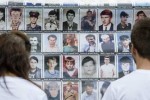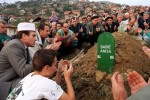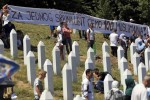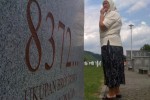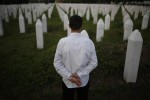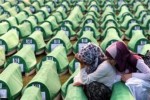MAIN EVENTS
|
11 July 2019
Iniziative (EN) -
Maison de la Paix (EN)

Also this year the Fondazione Mediterraneo takes part in the 24th anniversary of the Srebrenica massacre: 8,000 young people slaughtered and over 30,000 women and girls deported.
A few scattered houses inhabited mostly by some elderly widow, a memorial to the victims of the war and around expanses of fields as far as the eye can see. Fields that could be cultivated, if only there were still the arms to do it. From here you get to Srebrenica in less than half an hour, descending along the road that Ratko Mladic and his troops of executioners traveled after the definitive fall of the city. The physiognomy of the small downtown square has recently been modified by an impressive red building that houses a hotel and a Turkish bank. Next to it, the minaret of the main city mosque is dominated by the dome of the Orthodox church. After what happened in the first half of the 1990s, the cohabitation between the Serbian community and the Muslim minority is a daily challenge. The latter, too, is now bothered by the noisy celebrations machine that is activated every year on 11 July, the annual parade of international delegations, the spotlights that come on for half a day and then go off again until the following year. "It is true, this will be the first anniversary after Mladic's conviction and the closing of the Hague Court of Justice - recognizes Bekir, who was a child during the war - but here the news of convictions come as a distant echo, which does not it shifts the daily balances of ordinary people ".
The survivors and relatives of the victims are forced to live every day with the memory of the genocide and to deal with a moral and material reconstruction that even after so many years is still struggling to take off.
"The process of reconciliation continues to be hampered by nationalist ideologies that throw salt on the wounds of a drama begun long before what the world remembers," explains Hasan Hasanovic, curator of the documentation center of the Potocari memorial, in which he is buried his father too. The siege of the Serbian nationalists in the city began on a spring day of twenty-six years ago, in 1993. "The UN had negotiated a cease-fire, the people thought they could take a breath and we children went out to play football in the schoolyard - he remembers - but suddenly, from the surrounding mountains, grenades began to rain on the city. One hit the playing field in full and exploded a few meters away from me ».
That day Hasan saved himself by miracle but saw fourteen of his classmates die. The slaughter that would have taken place two years later also marked the failure of the international community, as also recalled by the photographic exhibition set up in the premises of the former UN base of Potocari.
With the 33 burials this year, the total burial will exceed 6,900 but the long process to restore an identity to the remains of more than eight thousand victims continues, also because the woods around Srebrenica continue to return the bones buried in the mass graves.
Dragana Vucetic, a forensic anthropologist from the research center on missing persons in Tuzla, confirms that there are about a thousand victims still to be identified.
The Fondazione Mediterraneo, founded precisely to help the victims of the war in the former Yugoslavia, is at the side of these tormented populations.
- THE APPEAL OF 1994
- THE PRESS
- MEDNEWS
